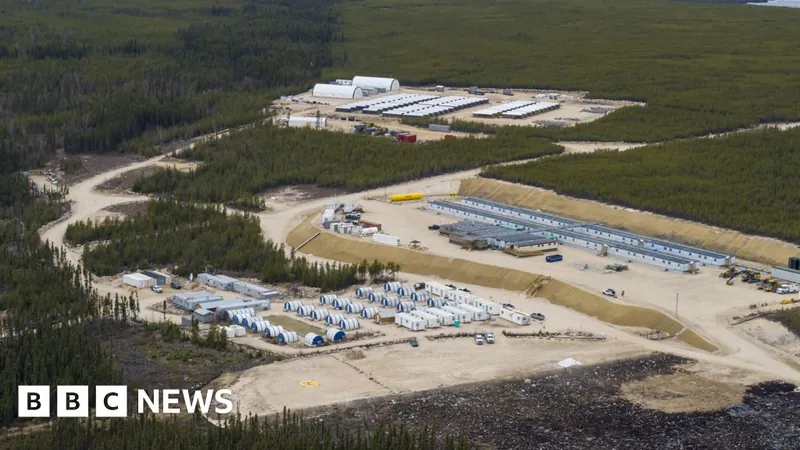
Why Canada Could Become the Next Nuclear Energy Superpower: Are We Ready for the Nuclear Revival?
2024-11-14
Author: Benjamin
Introduction
Uranium is experiencing a remarkable resurgence, driven primarily by a renewed focus on nuclear energy as a solution to the urgent climate crisis. With rich high-grade uranium deposits, Canada is poised to emerge as a prominent player in the global nuclear energy landscape. But can Canada truly harness this potential?
The Changing Landscape of Nuclear Energy
Leigh Curyer, a seasoned veteran in uranium mining with nearly two decades of experience, has witnessed transformative changes in the industry. Following the Fukushima disaster in Japan in 2011, public perception of nuclear energy plummeted, and uranium prices fell drastically. However, in the last five years, the tides have turned dramatically—uranium prices have skyrocketed by more than 200%, making it one of the year’s top-performing commodities.
Advocates for Nuclear Energy
The change in sentiment has been fueled by influential advocates. In 2018, Bill Gates highlighted nuclear energy’s role in combating climate change, which began reshaping public discourse. By 2022, UK Prime Minister Boris Johnson championed a policy requiring that at least 25% of the UK's energy come from nuclear sources, and shortly thereafter, the European Union declared nuclear energy to be climate-friendly. Such pivotal events have acted as catalysts for the uranium industry.
NexGen Energy and Canada's Role
Curyer’s company, NexGen Energy, is at the forefront of this revival, leading the charge with the largest in-development uranium mine located in Canada’s Athabasca Basin in northern Saskatchewan. Though the mine isn’t expected to start operations until at least 2028, NexGen has already soared in valuation to nearly $4 billion. If regulatory approvals are secured, NexGen could position Canada as the world’s largest uranium producer within the next decade, surpassing Kazakhstan.
Investment Surge
The influx of capital has been extraordinary, with Curyer noting a surge in interest from global investors—something unprecedented in his previous 17 years in the industry. As uranium-rich Saskatchewan attracts new exploratory projects, companies are re-opening dormant mines to meet the anticipated rise in demand following a collective commitment made at the recent COP28 climate conference by nearly two dozen countries to triple their nuclear energy output by 2050.
The Urgency for Nuclear Energy
Nuclear energy is increasingly recognized for its low carbon emissions, especially compared to fossil fuels like natural gas and coal. Currently, around 10% of the world's electricity is generated from nuclear power, while over half still comes from fossil sources. With COP29 emphasizing the urgent need for investment in nuclear projects—especially after the UN indicated existing efforts fall short—Canada’s role as a uranium supplier is becoming critically important.
Geopolitical Considerations
The geopolitical landscape has also altered dramatically post-Russia’s invasion of Ukraine, prompting the United States, which has traditionally depended on Russia for enriched uranium, to seek alternatives. Curyer believes his project could be vital to America’s nuclear future as the nation endeavors to reduce reliance on foreign suppliers and increase domestic uranium exploration.
Canada’s Unique Advantage
What sets Canada apart is the exceptional quality of its Athabasca uranium, categorized as high-grade by experts. Canada is classified as a "tier-one nuclear nation," meaning it can effectively manage the entire supply chain of nuclear fuel, from mining to manufacturing. In addition to being the world’s second-largest uranium producer, contributing about 13% of global output, NexGen anticipates that its operational mine could jump this figure to as much as 25%.
Challenges and Criticism
Despite the optimism, the nuclear energy sector faces criticism and skepticism. Some environmental groups raise alarms over the costs and long timelines associated with nuclear projects, asserting that these do not align with the urgency of climate action. Notably, while 60 new nuclear reactors are currently under construction across 16 countries—primarily in China—more than 100 nuclear plants have been shut down globally over the last two decades due to safety and economic concerns.
Public Sentiment and Future Prospects
Furthermore, not all regions in Canada are on board with nuclear development. British Columbia, which has its own uranium deposits, has not permitted any nuclear facilities since 1980. Additionally, fears regarding radioactive waste management and catastrophic accidents like Fukushima still linger among both the public and regulatory bodies.
However, advocates believe that the safety and reliability of nuclear technology have significantly improved. A 2023 Ipsos poll indicated that 55% of Canadians support nuclear energy, signaling a shift in public sentiment. Nonetheless, history is a reminder to approach with caution—previous uranium booms in Canada have led to dramatic busts, such as the collapse of Uranium City, which once thrived on mining.
Conclusion
As NexGen looks forward to starting construction on its mine as early as next year, the industry's future remains uncertain. With about 100 companies now exploring for uranium in Saskatchewan, the investment landscape is evolving rapidly. Still, key players like Cameco, which has been mining uranium since 1988, warn that the path from exploration to production can be long and complex.
In summary, Canada's vision of becoming a nuclear superpower is filled with potential, but it comes with challenges and risks. The stakes are high; with a looming global uranium shortage on the horizon and an increasing demand for cleaner energy, Canada’s nuclear future hangs in the balance. Can the country rise to the occasion and seize this golden opportunity, or will history repeat itself in a cyclical pattern of boom and bust? The world is watching closely as this critical chapter in the nuclear renaissance unfolds.









 Brasil (PT)
Brasil (PT)
 Canada (EN)
Canada (EN)
 Chile (ES)
Chile (ES)
 España (ES)
España (ES)
 France (FR)
France (FR)
 Hong Kong (EN)
Hong Kong (EN)
 Italia (IT)
Italia (IT)
 日本 (JA)
日本 (JA)
 Magyarország (HU)
Magyarország (HU)
 Norge (NO)
Norge (NO)
 Polska (PL)
Polska (PL)
 Schweiz (DE)
Schweiz (DE)
 Singapore (EN)
Singapore (EN)
 Sverige (SV)
Sverige (SV)
 Suomi (FI)
Suomi (FI)
 Türkiye (TR)
Türkiye (TR)